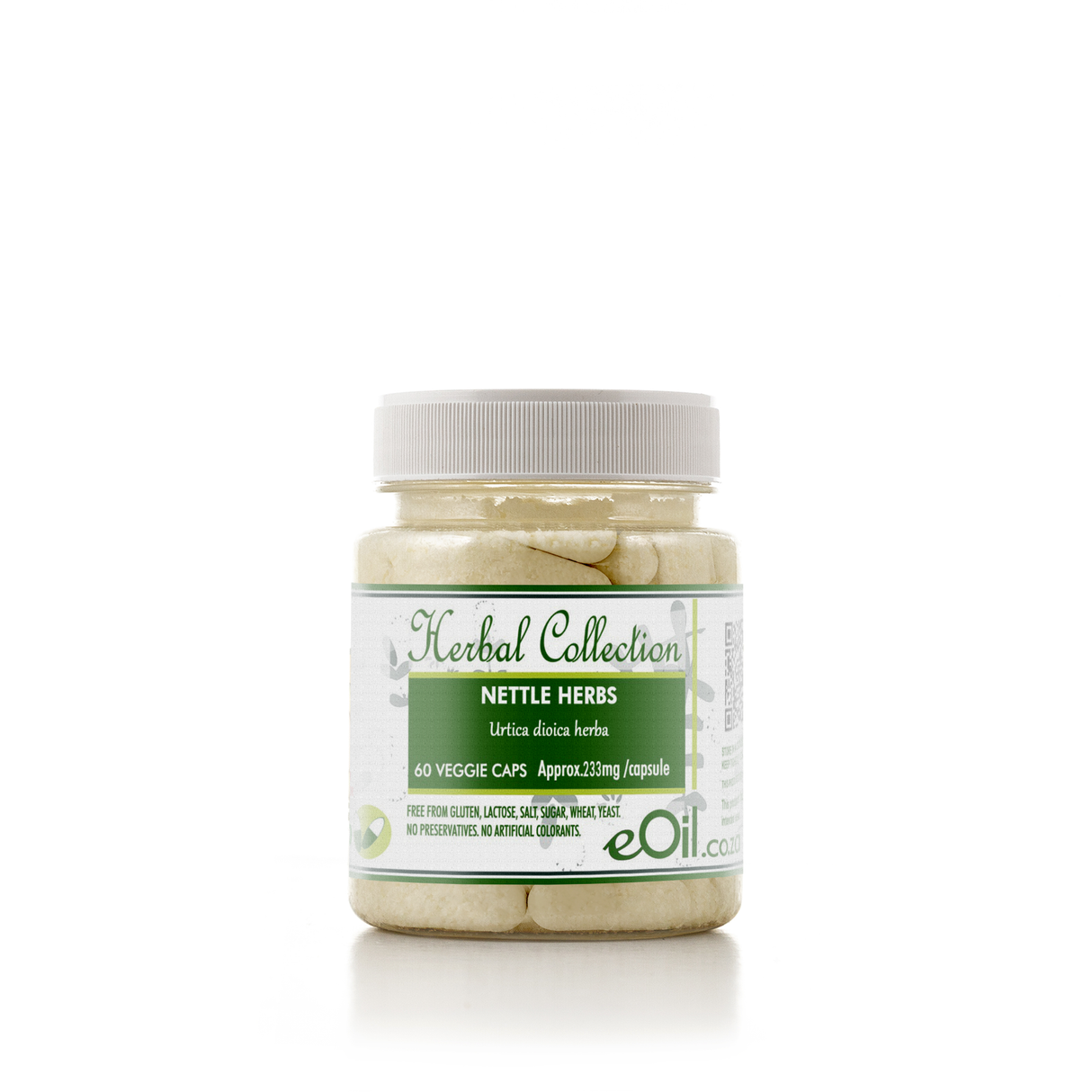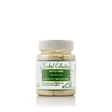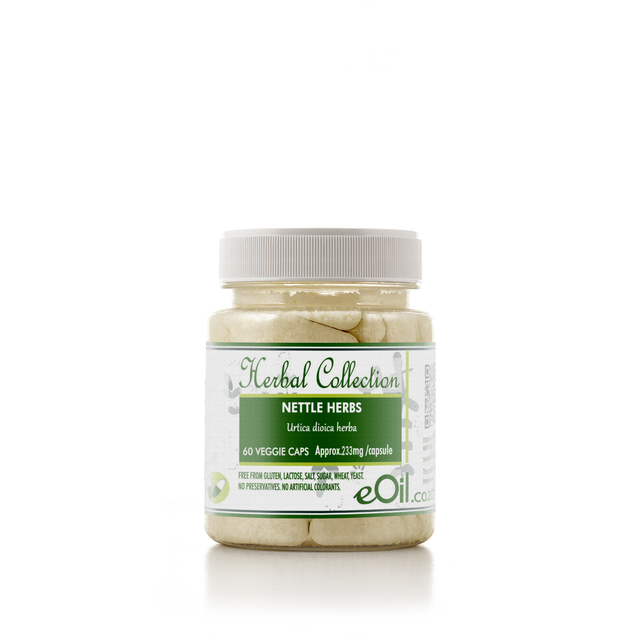Nettle Stinging Herb vegan capsules - Herbal Collection
Nettle Stinging Herb vegan capsules - Herbal Collection is backordered and will ship as soon as it is back in stock.
Description
Description
Nettle Stinging Herb capsules deliver a pure, plant-based supplement rich in vitamins and minerals to support natural wellness and daily vitality.
Traditionally valued for promoting joint and urinary system comfort, these vegan capsules are allergen-free and easy to use, ideal for balanced lifestyles and nutritional routines
TRADITIONALLY USED FOR
Nettle Tincture (Liquid Herbal Extract)
- Rapid-acting form for systemic support
- Used to relieve hay fever/allergies, support joints, relieve arthritis pain, and improve prostate and urinary health
- Directions: 1–2 ml (20–40 drops) in water, 2–3 times/day before meals
- Best for: Allergy attacks, joint pain flare-ups, fast absorption needs
Nettle Dried Herb
- Infusion or tea for ongoing routine wellness
- Brewed tea or added to soups/smoothies for inflammation management, mild allergies, urinary tract support, skin health, and gentle daily cleansing
- Directions: 2–4 g per cup (1 heaped tsp), steep in boiled water 10–15 min, drink up to 3x/day
- Can be used topically as a rinse for scalp/hair or skin
- Best for: DIY herbalists, gentle daily support, food and topical infusion
Vegan Capsule (Nettle Herb)
- Convenient, on-the-go routine support
- Provides the full spectrum of nettle’s leaf and stem nutrients for seasonal allergies, joint health, circulation, immune and energy support
- Directions: 300–600 mg extract or powder, 1–3x daily or as recommended
- Best for: Busy lifestyles, travelers, those who dislike tea or tincture taste
Vegan Capsule (Nettle Root)
- Focused men’s health support
- Root extract is used for urinary function, prostate health/BPH, hair vitality, hormone balance, and kidney support
- Directions: 300–600 mg root extract/capsule, 1–3x/day
- Best for: Men’s prostate/urinary concerns, hair loss/androgen balance, BPH symptom management
Nettle Product Recap Table
| Product Type | Main Benefits | Typical Use & Dosage | Best For | Not For |
|---|---|---|---|---|
| Tincture | Allergy, joint, anti-inflammatory, prostate, detox | 1–2 ml in water, 2–3x daily | Acute relief, quick-absorb | Pregnancy, severe kidney/heart, kids |
| Dried Herb | Tea for daily immune, allergy, detox, skin, UTI | 2–4 g/cup infused, 1–3x daily as tea/food | Everyday use, DIY home blends | As above |
| Vegan Capsule Herb | All-round support—immunity, joint, energy, allergy | 300–600 mg 1–3x daily | Busy schedules, travel, vegans | Under 12, pregnancy, allergy to nettle |
| Vegan Capsule Root | Men’s health—prostate, BPH, & hair | 300–600 mg 1–3x daily | Men’s urinary & prostate focus | As above, plus women seeking leaf benefits |
Quick Facts & Cautions
- Nettle is rich in vitamins A, C, K, iron, calcium, magnesium, and potent antioxidants
- Avoid during pregnancy/breastfeeding unless supervised
- Possible mild stomach upset or allergies in sensitive individuals; rare drug interactions: consult if on diuretics, blood thinners, diabetes, or blood pressure meds
- Store capsules and dried herbs airtight in a cool, dry place
INFORMATION
Source : http://www.wikiphyto.org/wiki/Nettle
Reference on http://www.wikiphyto.org
Translation in English by Google Translate (go to the page of the source linked | on Chrome cellphones go on the 3 dots on the top right and select translate in your preferred language | on laptop right click your mouse and select option translate when hoovering on the page
plant name
- stinging nettle , great nettle
- Stinging nettle , little nettle , shrike
International Latin denomination
botanical family
Urticaceae
Description and habitat
- Well-known, invasive perennial herb, 60-120 cm tall, with pointed opposite leaves, covered with stinging, bristly hairs. The tip of these hard, conical bristles break upon contact and inject the stinging substances contained therein
- Nettles are cosmopolitan “weeds”
- Nitrophilic and ruderal, they are very common around houses, in rubble and ditches
History and tradition
- Considered a panacea in the Middle Ages, especially for hemorrhages
- Do not confuse them with the White nettle or Lamiaceae white deadnettle ( Lamium album L.)
- They are very "animic" plants because they synthesize specific substances of the animal kingdom (histamine, serotonin, acetylcholine)
Parts used
- Yellowish colored leaves and roots (with long branching rhizomes)
Dosage forms available
- Whole plant tincture
- EPS of aerial parts
- Roots EPS
- Whole plant fluid extract
- Fluid root extract
- Root dry extract
- Dry leaf extract
Usual dosages
- Leaf tea: classic infusion, 5 grams of leaves three times a day
- Root tea in decoction: mix 1.5 grams of coarsely powdered drug with cold water, heat and keep boiling for 1 minute, infuse 10 minutes, strain
Composition
Main components of the plant
Leaves :
- Flavonoids (1-2%) quercetol glucosides and rutinosides , kaempferol and isorhamnetol .
- Mineral elements (20%) Calcium, Potassium, Silicon in the form of partially soluble silicates (1 - 4%), Iron content 41 mg/100 g
- Organic acids, phenolic acids : caffeic acid , chlorogenic acid , caffeoylmalic acid
- Coumarins : scopoletol
- Sterols : sitosterol
- Traces of nicotine
- Glyco-proteins, amino acids (valine, alanine, glutamine…), lipids, vitamins, sugars
- Low amounts of histamine , serotonin , acetylcholine , and formic acid (in stinging hairs)
- Chlorophyll (2.7%)
Roots :
- Lectins : in particular 0.1% UDA = Urtica Dioica Agglutinin (single polypeptide chain) with a molar mass of 8500 Dalton
- Polysaccharides (two glycans , two glucogalacturonans , one arabinogalactan )
- Sterols: sitosterol , hydroxysitosterols and their glucosides, 3-glucosyl sitosterol palmitate
- Lignans ( secoisolariciresinol , neo-olivil )
- Ceramides ( sphingolipid metabolites ) and fatty acids (octadecanoic acids)
- Other phenolic compounds , tannins , scopoletol , phenylpropane derivatives
Main components of buds or young shoots
Main components of essential oil
Properties
Plant properties
Sheet properties :
- Diuretic, removes urea, uric acid and chlorides [1] , [2] , antigout, causes a moderate decrease in blood pressure
- "depurative", cholagogue, would stimulate the enzymatic production of the pancreas
- Anti-rheumatic (derivatives of caffeic acid inhibit the arachidonic acid cascade in vitro ), preventive of arteriosclerosis, anti-allergic (inhibition of the PAF of neutrophils Platelet Activating Factor), caffeoylmalic acid would be one of the antirheumatic active ingredients, as an inhibitor of cyclooxygenase biosynthesis, effect similar to 200 mg/day of diclofenac [3] , leaf extracts inhibit the biosynthesis of enzymes of the arachidonic cascade, (cyclo-oxygenases COX-1 and COX-2), block the biosynthesis of prostaglandins and thromboxane [4]
- Anti-inflammatory [5] , analgesic [6] , [7]
- Antimicrobial, anti-ulcer [8]
- Anti-anemic (stimulates hematopoiesis), formerly industrial source of chlorophyll (even if it does not contain more than other leaves), remineralizing
- Hepatoprotective and antioxidant [9]
- Hypoglycemic by inhibiting the intestinal absorption of glucose [10] , and by stimulating insulin secretion by the islets of Langerhans [11]
- Cardiovascular protector [12]
- Anti-allergic [13] , with anti-inflammatory effect inhibition of prostaglandin synthesis by inhibition of cyclooxygenase-1 (COX-1), Cyclooxygenase-2 (COX-2), and HPGDS (Hematopoietic Prostaglandin D(2 ) synthase) [14]
- Immuno-stimulant by activity on the function of neutrophils ( flavonoids ) [15]
- Cancer prevention ( phenolic acids ) [16]
- Antiviral potential by affinity with the ACE-2 receptor [17]
Root properties :
- Astringent due to tannin content and antiphlogistic due to lectins ( UDA ) and polysaccharides
- Effective in benign prostatic hyperplasia [18]
- A fatty acid is an aromatase inhibitor responsible for the conversion of testosterone to 17-beta-estradiol
- Lignans ( secoisolariciresinol ) and octadecanoic acids would prevent SHBG (sex hormone binding globulin) from binding to its receptor [19]
- Antiproliferative activity of hydro-alcoholic extracts on prostate tissue ( UDA and polysaccharides ) [20]
- Likely inhibition of testosterone-5-alpha-reductase (unproven)
- Inhibition of NF-kappaB activation [21]
- Hydroalcoholic extracts improve sperm count and motility and inhibit nicotine -induced adverse effects on sperm quality [22]
- Clinical observations show a decrease in voiding frequency, post-void residual, prostate volume, and hormonal levels with extract doses of 600 to 1200 mg per day, and over periods of 3 to 6 months.
- Hypotensive by vasorelaxation effect mediated by the release of endothelial nitric oxide (NO), by the opening of potassium channels, and by a negative inotropic effect [23] , causes aortic vasoconstriction due to the activation of alpha1- receptors adrenergic [24] and by a natriuretic action [25]
- Inhibition of SARS-CoV-1 replication by a lectin , ( Urtica dioica agglutinin ) [26]
Bud properties
Properties of essential oil
Directions
Indications of the whole plant (phytotherapy)
Leaves :
- Moderate acne, hyperseborrhoea
- Painful joints (it is not a powerful anti-inflammatory, it is mainly used for drainage in rheumatological conditions)
- Hyperuricaemia
- Remineralization, osteoporosis
- Mainly iron deficiency anemias
- Asthenia
- Hair loss: rubefacient properties, activation of hair metabolism
Roots :
- Voiding disorders of prostate adenomas in stages I and II, and logically fibroids (mainly antiproliferative and much less hormonal action)
- Female hyperandrogenism [27]
- Synergy of action with Pygeum africanum [28]
- To be tried in male acne (logical indication)
- Other: inflammation of the urinary tract, prevention of nephrolithiasis
Indications of the bud (gemmotherapy)
Specific indications of essential oil (aromatherapy)
Known or suspected mode of action
Leaf :
- Inhibition of the arachidonic acid cascade, inhibition of neutrophil PAF (Platelet Activating Factor)
Root :
- Lectins (proteins whose name comes from the Latin “legere” = to read, to choose, “to select" [ 29] ) bind reversibly to osidic receptors on cell membranes
- Inhibition of aromatase responsible for the conversion of testosterone to 17-beta-estradiol
- Inhibition of SHBG (sex hormone binding globulin) binding to its receptor
- Antiproliferative activity on prostate tissue
- Likely inhibition of testosterone-5-alpha-reductase (unproven)
Usual formulations
Gardeners know the antifungal properties of fermented nettle juice or manure on their vegetables
Manufacture of nettle manure: macerate in 10 liters of water (preferably rain) 1.5 kg of young chopped nettle leaves (not gone to seed), filter the maceration obtained (bad smell, it is normal) after a fortnight
Use :
Dilution of 2 liters of manure for 10 liters of water (preferably with rainwater)
• As a spray on the ground against cryptogamic diseases such as mildew
• Growth activator (rich in mineral salts)
Dilution of 1 liter of manure for 10 liters of water:
• Insecticide (aphids) in fine spray on the leaves
Without dilution:
• Compost activator
Regulations
- French Pharmacopoeia list A (aerial part, underground part of Urtica dioica )
- French Pharmacopoeia list A (root, aerial part of Urtica urens )
Possible side effects and precautions for use
- Drug interactions are described, but with seed extracts [30]
Bibliographic references
- Go↑ Cáceres A, Girón LM, Martínez AM. Diuretic activity of plants used for the treatment of urinary ailments in Guatemala. J Ethnopharmacol. 1987May;19(3):233-45. PMID 3669686
- Go↑ Martinez, AM (1984a) Contribución al Estudio Farmacológico de un Grupo de Plantas Medicinales Utilizadas coma Diureticos (Tesis). Facultad de Ciencias Químicas y Farmacia, Universidad de San Carlos, Guatemala, 65 pp.
- Go↑ Chrubasik S, Shvartzman P. Rheumatic Pain Treatment with Stinging Nettle (URTICAE FOLIUM/HERBA). Consistency 1/99. [1]
- Go↑ Ait Haj Said Amal, Sbai El Otmani Ibrahim, Derfoufi Sanae, Benmoussa Adnane. Highlighting the nutritional and therapeutic potential of stinging nettle (Urtica dioica L.). HEGEL, 2016, Vol 6, N° 3 DOI: https://doi.org/10.4267/2042/61406 (= Highlights on nutritional and therapeutical value of stinging nettle (Urtica Dioica)
- Go↑ Obertreis B, Giller K, Teucher T, Behnke B, Schmitz H. Anti-inflammatory effect of Urtica dioica folia extract in comparison to caffeic malic acid. Arzneimittelforschung. 1996 Jan;46(1):52-6. PMID 8821518
- Go↑ Valiollah Hajhashemi, Vahid Klooshani. Antinociceptive and anti-inflammatory effects of Urtica dioica leaf extract in animal models. Avicenna Journal of Phytomedicine, 2012 Vol. 3, No. 2, Spring 2013, 193-200
- Go↑ Asgarpanah, Jinous & R, Mohajerani. (2012). Phytochemistry and pharmacologic properties of Urtica dioica L. Journal of Medicinal Plants Research Vol. 6(46), p. 5714-5719, 3 December, 2012 DOI: 10.5897/JMPR12.540 full text
- Go↑ Gülçin I, Küfrevioglu OI, Oktay M, Büyükokuroglu ME. Antioxidant, antimicrobial, antiulcer and analgesic activities of nettle (Urtica dioica L.). J Ethnopharmacol. 2004 Feb;90(2-3):205-15. PMID 15013182
- Go↑ Mehmet Kanter, Omer Coskun, Mustafa Budancamanak. Hepatoprotective effects of Nigella sativa L and Urtica dioica L on lipid peroxidation, antioxidant enzyme systems and liver enzymes in carbon tetrachloride-treated rats. World Journal of Gastroenterology, 2005;11(42):6684-6688 [2]
- Go↑ Bnouham M, Merhfour FZ, Ziyyat A, Mekhfi H, Aziz M, Legssyer A. Antihyperglycemic activity of the aqueous extract of Urtica dioica. Fitoterapia. 2003 Dec;74(7-8):677-81. PMID 14630172
- Go↑ Bijan Farzami, D. Ahmadvand, S. Vardasbi, FJ Majin, Sh. Khaghani. Induction of insulin secretion by a component of Urtica dioica leave extract in perifused Islets of Langerhans and its in vivo effects in normal and streptozotocin diabetic rats. Journal of Ethnopharmacology, Volume 89, Issue 1, November 2003, Pages 47-53 [3]
- Go↑ El Haouari M, Rosado JA. Phytochemical, Anti-diabetic and Cardiovascular Properties of Urtica dioica L. (Urticaceae): A Review. Mini Rev Med Chem. 2019;19(1):63-71. doi: 10.2174/1389557518666180924121528. PMID 30246639
- Go↑ Mittman P. Randomized, double-blind study of freeze-dried Urtica dioica in the treatment of allergic rhinitis. PlantaMed. 1990 Feb;56(1):44-7. PMID 2192379
- Go↑ Roschek B Jr, Fink RC, McMichael M, Alberte RS. Nettle extract (Urtica dioica) affects key receptors and enzymes associated with allergic rhinitis. Phytother Res. 2009 Jul;23(7):920-6. PMID 19140159
- Go↑ Akbay P, Basaran AA, Undeger U, Basaran N. In vitro immunomodulatory activity of flavonoid glycosides from Urtica dioica L. Phytother Res. 2003 Jan;17(1):34-7. PMID 12557244
- Go↑ Nurdan Sena Değirmenci, Zeynep Ülker Akal, Lokman Alpsoy. Cytotoxic and Apoptotic Effects of Caffeic Acid and Caffeoyl Malic Acid on Brain Glioblastoma (U87 Mg). Bulletin of Pharmaceutical Research 2016;6(1):7-13 full text
- Go↑ Upreti, S., Prusty, JS, Pandey, SC, Kumar, A., & Samant, M. (2021). Identification of novel inhibitors of angiotensin-converting enzyme 2 (ACE-2) receptor from Urtica dioica to combat coronavirus disease 2019 (COVID-19). Molecular diversity, 1–15. Advance online publication. https://doi.org/10.1007/s11030-020-10159-2 . PMID 33398633
- Go↑ Safarinejad MR. Urtica dioica for treatment of benign prostatic hyperplasia: a prospective, randomized, double-blind, placebo-controlled, crossover study. J Herb Pharmacother. 2005;5(4):1-11. PMID 16635963
- Go↑ Hryb DJ, Khan MS, Romas NA, Rosner W. The effect of extracts of the roots of the stinging nettle (Urtica dioica) on the interaction of SHBG with its receptor on human prostatic membranes. PlantaMed. 1995 Feb;61(1):31-2. PMID 7700987
- Go↑ Konrad L, Müller HH, Lenz C, Laubinger H, Aumüller G, Lichius JJ. Antiproliferative Effect on Human Prostate Cancer Cells by a Stinging Nettle Root (Urtica dioica) Extract. Planta Medica 66 (2000) No. 1, 44-47. [4]
- Go↑ Rieihemann K, Behnke B, Schulze-Osthoff K. Plant extracts from stinging nettle (Urtica dioica), an antirheumatic remedy, inhibit the proinflammatory transcription factor NF—KB. FEBS Letters, 442 (1999) 89-94. PMID 9923611
- Go↑ Jalili C, Salahshoor MR, Naseri A. Protective effect of Urtica dioica L against nicotine-induced damage on sperm parameters, testosterone and testis tissue in mice. Iran J Reprod Med. 2014 Jun;12(6):401-8. PMID 25071848 .
- Go↑ Testai L, Chericoni S, Calderone V, Nencioni G, Nieri P, Morelli I, Martinotti E. Cardiovascular effects of Urtica dioica L. (Urticaceae) roots extracts: in vitro and in vivo. Journal of Ethnopharmacology, 2002 Jun;81(1):105-9. PMID 12020933
- Go↑ Legssyer A, Ziyyat A, Mekhfi H, Bnouham M, Tahri A, Serhrouchni M, Hoerter J, Fischmeister R. Cardiovascular effects of Urtica dioica L. in isolated rat heart and aorta. Phytother Res. 2002 Sep;16(6):503-7. PMID 12237804
- Go↑ Tahri A, Yamani S, Legssyer A, Aziz M, Mekhfi H, Bnouham M, Ziyyat A. Acute diuretic, natriuretic and hypotensive effects of a continuous perfusion of aqueous extract of Urtica dioica in the rat. Journal of Ethnopharmacology 73 (2000) 95-100. PMID 11025144
- Go↑ Kumaki, Y., Wandersee, MK, Smith, AJ, Zhou, Y., Simmons, G., Nelson, NM, Bailey, KW, Vest, ZG, Li, JK, Chan, PK, Smee, DF, & Barnard , DL (2011). Inhibition of severe acute respiratory syndrome coronavirus replication in a lethal SARS-CoV BALB/c mouse model by stinging nettle lectin, Urtica dioica agglutinin. Antiviral research, 90(1), 22–32. https://doi.org/10.1016/j.antiviral.2011.02.003 . PMID 21338626
- Go↑ Najafipour, F., Rahimi, AO, Mobaseri, M., Agamohamadzadeh, N., Nikoo, A., & Aliasgharzadeh, A. (2014). Therapeutic effects of stinging nettle (Urtica dioica) in women with Hyperandrogenism. Int J Current Res Acad Rev, 2(7), 153-160.
- Go↑ Williamson EM Synergy and other interactions in phytomedicines. Review. Phytomedicine, Vol. 8(5), p. 401–409 full text
- Go↑ Bruneton Jean. Pharmacognosy, Phytochemistry, Medicinal Plants. Ed. Tec and Doc. 1997.
- Go↑ Agus HH, Tekin P, Bayav M, Semiz A, Sen A. Drug interaction potential of the seed extract of Urtica urens L. (dwarf nettle). Phytother Res. 2009 Dec;23(12):1763-70. doi: 10.1002/ptr.2848. PMID 19441062
- Koch E. Extracts from Fruits of Saw Palmetto (Sabal serrulata) and Roots of Stinging Nettle (Urtica dioica): Viable Alternatives in the Medical Treatment of Benign Prostatic Hyperplasia and Associated Lower Urinary Tracts Symptoms. PlantaMed. 2001 Aug;67(6):489-500. PMID 11509966
- Droz Bartholet Dauvilliers Sophie; under the direction of Jacqueline Vaquette. Stinging nettles Urtica dioica - Urtica urens: interest in benign prostatic hypertrophy. Thesis: Exercise thesis: Pharmacy: Besancon: 1998
- Lenglen Severine; under the dir. by Francois Bailleul. Stinging nettle (Urtica dioica L.) in benign prostatic hyperplasia. Pharmacy exercise thesis: Lille 2: 2000
- DRAGHI Francine. Stinging nettle, bibliographic study. Pharmacy exercise thesis, Nancy 2005. [5]
- Committee on Herbal Medicinal Products (HMPC) EMA/HMPC/461156/200824 September 2012. Assessment report on Urtica dioica L., Urtica urens L., their hybrids or their mixtures, radix. [6]
CAUTION
Store in a cool, dry place, away from light. Keep tightly closed, away from the reach of Children and pets.
Do not exceed the daily dose.
This product is not intended to prevent or cure any form of illness or disease.
If you are pregnant or nursing ; If you have a medical condition or are in the course of medical treatment ; If you are programmed for theater/operation in the near future, please consult your healthcare practitioner before using this product.
This product cannot replace a varied and balanced diet and a healthy lifestyle.
This product has not been evaluated by the SAHPRA for its quality, safety or intended use.
For More Information please check our General Safety Herbal products Page





